-
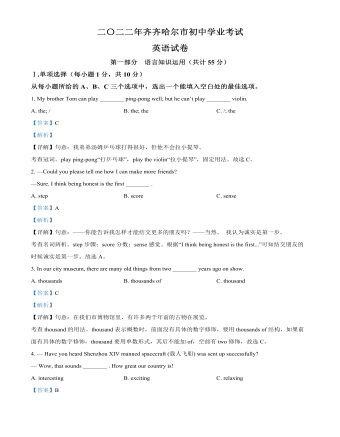
2022年黑龙江省齐齐哈尔市中考英语真题(解析版)
B: For 3 days. I expect togo there again.A: Lucky you. I had to stayat home. But I’m planning to travel to Mount Changbai.B: Oh, that’s a good place.I went there three years ago.
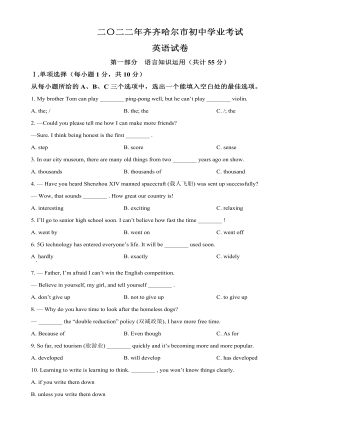
2022年黑龙江省齐齐哈尔市中考英语真题(原卷版)
(A: Sun Lan B: Li Yue C: Waiter)A: Hi! This is Sun Lan. MayI speak to Li Yue?B: Hi, Sun Lan! ________41________.Are you in Qiqihar now?A: Yes, I came back last night.
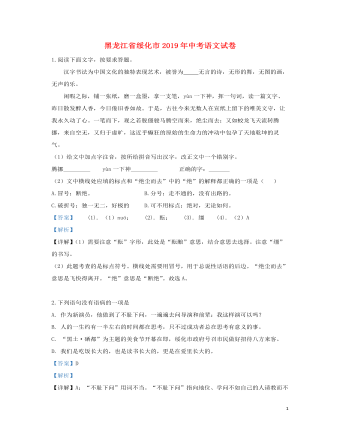
黑龙江省绥化市2019年中考语文真题试题(含解析)
失掉了他信力,就会疑,一个转身,也许能够只相信了自己,倒是一条新生路,但不幸的是逐渐玄虚起来了。信"地"和"物",还是切实的东西,国联就渺茫,不过这还可以令人不久就省悟到依赖它的不可靠。一到求神拜佛,可就玄虚之至了,有益或是有害,一时就找不出分明的结果来,它可以令人更长久的麻醉着自己。
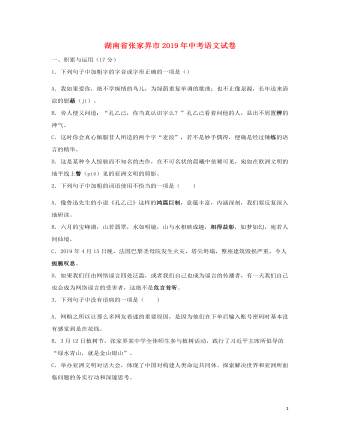
湖南省张家界市2019年中考语文真题试题(含解析)
读书不能死章句,需要思考一个“活”字。李白在《嘲鲁儒》中说:“鲁叟谈五经,白发死章句。问以经济策,茫如坠烟雾。”诗人对那些夸夸其谈而没有真才实学的“鲁叟”进行了辛辣的嘲讽。这些人谈起五经头头是道,问起经世济民之策却茫然无知。他们拿腔拿调,架子十足,却死于章句,不知时变。陆游《冬夜读书示子聿》中的观点,则更加值得那些“鲁叟”们深思。他说“纸上得来终觉浅,绝知此事要躬行”,言词朴素,满含哲理,诗中提出的理论与实践相结合的观点,至今犹有现实意义。只有在实践中才能得真知、悟真谛,真正学有所获,学有所用。
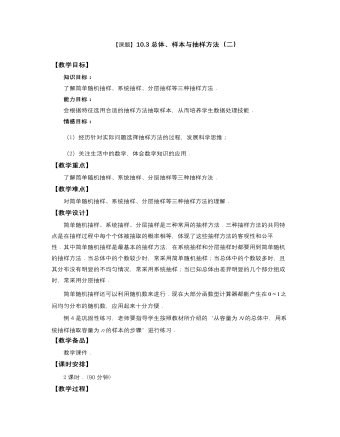
高教版中职数学基础模块下册:10.3《总体、样本与抽样方法》优秀教案设计
教 学 过 程教师 行为学生 行为教学 意图时间 *揭示课题 10.3总体、样本与抽样方法(二) *创设情境 兴趣导入 【问题】 用样本估计总体时,样本抽取得是否恰当,直接关系到总体特性估计的准确程度.那么,应该如何抽取样本呢? 介绍 质疑 了解 思考 启发 学生思考 0 5*动脑思考 探索新知 【新知识】 下面介绍几种常用的抽样方法. 1.简单随机抽样 从一批苹果中选取10个,每个苹果被选中的可能性一般是不相等的,放在上面的苹果更容易被选中.实际过程又不允许将整箱苹果倒出来,搅拌均匀.因此,10个苹果做样本的代表意义就会打折扣. 我们采用抽签的方法,将苹果按照某种顺序(比如箱、层、行、列顺序)编号,写在小纸片上.将小纸片揉成小团,放到一个不透明的袋子中,充分搅拌后,再从中逐个抽出10个小纸团.最后根据编号找到苹果. 这种抽样叫做简单随机抽样. 简单随机抽样必须保证总体的每个个体被抽到的机会是相同的.也就是说,简单随机抽样是等概率抽样. 抽签法(俗称抓阄法)是最常用的简单随机抽样方法.其主要步骤为 (1)编号做签:将总体中的N个个体编上号,并把号码写到签上; (2)抽签得样本:将做好的签放到容器中,搅拌均匀后,从中逐个抽出n个签,得到一个容量为n的样本. 当总体中所含的个体较少时,通常采用简单随机抽样.例如,从某班抽取10位同学去参加义务劳动,就可采用抽签的方法来抽取样本. 当总体中的个体较多时,“搅拌均匀”不容易做到,这样抽出的样本的代表性就会打折扣.此时可以采用“随机数法”抽样. 产生随机数的方法很多,利用计算器(或计算机)可以方便地产生随机数. CASIO fx 82ESPLUS函数型计算器(如图10-3),利用 · 键的第二功能产生随机数.操作方法是:首先设置精确度并将计算器显示设置为小数状态,依次按键SHIFT 、 MODE、 2 ,然后连续按键 SHIFT 、 RAN# ,以后每按键一次 = 键,就能随机得到0~1之间的一个纯小数. 采用“随机数法”抽样的步骤为: (1)编号:将总体中的N个个体编上号; (2)选号:指定随机号的范围,利用计算器产生n个有效的随机号(范围之外或重复的号无效),得到一个容量为n的样本. 讲解 说明 引领 分析 仔细 分析 关键 语句 观察 理解 记忆 带领 学生 分析 20
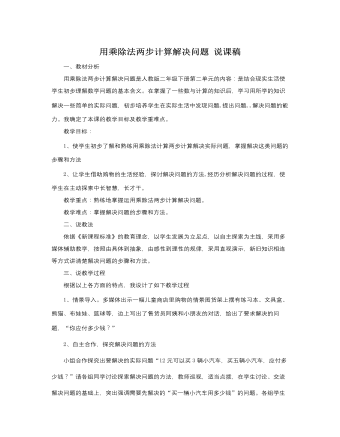
人教版新课标小学数学二年级下册用乘除法两步计算解决问题说课稿
例2是面包房买卖面包的情境。解决问题的重点是学会使用小括号列综合算式,并了解小括号的作用。通过学生熟悉的购买面包的情境,解决“还剩多少个”这个实际问题。仍然可以引导学生从不同的角度思考问题,启发列式为54-8-22或为54-(8+22)。第二种解法的综合算式,教材中特别强调“如果写成一个算式,应该使用小括号”,并明确“计算时先算小括号里面的”。因为是初次在列式时需要使用小括号,如果学生产生疑问,教师可组织学生通过回顾旧知,利用现实情境,明确使用小括号的必要性及使用方法。教学例2时可以采用与例1相似的教学方式。首先让学生观察下页图,也可以利用电教媒体创设情境,由学生提出问题,并启发学生思考如何解决。让学生充分交流研讨,畅谈自己的想法,然后着重说明解决问题的思路。列式计算时可以先分步列式,同时强调两种列式方法的内在联系,列综合算式时着重说明使用小括号的目的。
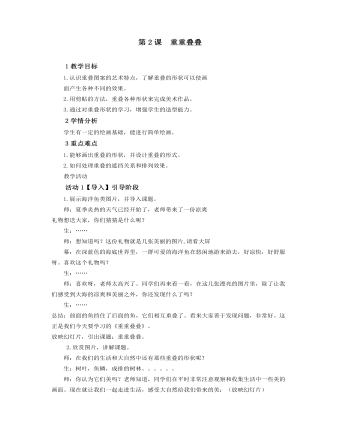
小学美术人教版二年级下册《第2课重重叠叠》教学设计说课稿
1.展示海洋鱼类图片,并导入课题。师:夏季炎热的天气已经开始了,老师带来了一份凉爽礼物想送大家,你们猜猜是什么呢?生:……师:想知道吗?这份礼物就是几张美丽的图片,请看大屏幕:在深蓝色的海底世界里,一群可爱的海洋鱼在悠闲地游来游去,好凉快,好舒服呀。喜欢这个礼物吗? 生:…… 师:喜欢呀,老师太高兴了。同学们再来看一看,在这几张漂亮的图片里,除了让我们感受到大海的凉爽和美丽之外,你还发现什么了吗?
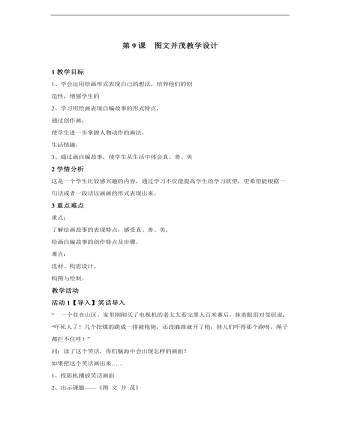
小学美术人教版六年级下册《第9课图文并茂2》教学设计说课稿
2学情分析这是一个学生比较感兴趣的内容,通过学习不仅能提高学生的学习欲望,更希望能根据一句话或者一段话以画画的形式表现出来。3重点难点重点:了解绘画故事的表现特点,感受真、善、美。绘画自编故事的创作特点及步骤。难点:选材、构思设计、构图与绘制。
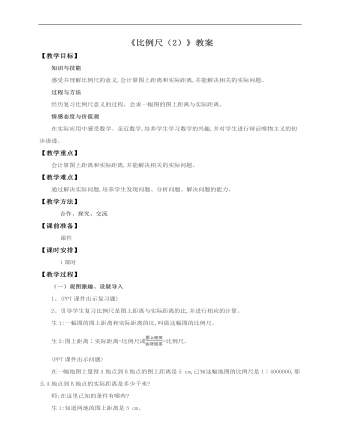
小学数学人教版六年级下册《第一课比例尺(2)》教案说课稿
(一)观图激趣、设疑导入 1、(PPT课件出示复习题)2、引导学生复习比例尺是图上距离与实际距离的比,并进行相应的计算。生1:一幅图的图上距离和实际距离的比,叫做这幅图的比例尺。生2:图上距离∶实际距离=比例尺或=比例尺。(PPT课件出示问题)在一幅地图上量得A地点到B地点的图上距离是5 cm,已知这幅地图的比例尺是1∶4000000,那么A地点到B地点的实际距离是多少千米?师:在这里已知的条件有哪些?生1:知道两地的图上距离是5 cm。生2:知道比例尺是1∶4000000。师:要解决的问题是什么?生:计算两地的实际距离是多少千米。师:这节课我们就接着来学习比例尺的应用,学习如何利用比例尺来解决实际问题,也就是已知比例尺和图上距离,求实际距离。(板书课题)【设计意图】通过把复习题中的习题变换已知和未知条件来变成本节课要解决的问题,使学生产生浓厚的兴趣,并且,也有助于培养学生举一反三、触类旁通的能力,使学生认识到数学知识的灵活性。(二)探究新知探究学习例2,已知比例尺和图上距离,求实际距离。1、PPT课件出示P54例3。下面是北京轨道交通路线示意图。地铁1号线从苹果园站至四惠东站在图中的长度大约是7.8 cm,从苹果园站至四惠东站的实际长度大约是多少千米?2、引导学生分析探究:师:从例题中可以知道哪些已知条件?生:可以知道两站的图上距离大约是7.8cm。师:这是从题目中直接读出来的,那么从所给的图中还能观察到什么条件呢?生:可以知道比例尺是1∶400000。布置学生小组讨论怎么样解决问题。学生以小组为单位进行合作学习,教师进行指导。3、汇报学习成果,师生共同探究:师:你们是怎么解答的?生1:通过列方程来解答的。生2:根据题意,可以先设实际长度为x cm,再根据“图上距离∶实际距离=比例尺”,列方程解答。师:解答时要注意什么?生1:要求实际距离是多少千米,但已知的图上距离是多少厘米,可以先设实际距离为x cm,算出实际距离的厘米数后,再化成千米数。生2:根据“图上距离∶实际距离=比例尺”,可以用解比例的方法求出实际距离。4、完成解答:(板书解题过程)图上距离:实际距离=比例尺解:设从苹果园站到四惠东站的实际长度是x cm。=x=7.8×400000x=31200003120000 cm=31.2 km答:从苹果园站到四惠东站的实际长度大约是31.2 km。5、拓展延伸:师:我们除了用方程解答之外,还可以用什么方法解答?生:可以用算术方法解答。师:可以怎样来分析呢?生:在“图上距离∶实际距离=比例尺”中,实际距离既可看成分数的分母,又可看成除法中的除数,所以可得出实际距离=图上距离÷比例尺。师:我们来共同完成解答:(板书过程)图上距离:比例尺=实际距离7.8÷=3120000(cm)3120000 cm=31.2 km答:从苹果园站到四惠东站的实际长度大约是31.2 km。6、牛刀小试。(1)师:我们一起来做两个练习题,看我们对新知识的掌握程度如何。(PPT课件出示)①教材P54做一做。先把教材P54做一做的图中的线段比例尺改写成数值比例尺,再用直尺量出图中河西村与汽车站之间的距离是多少厘米,并计算出两地的实际距离大约是多少。
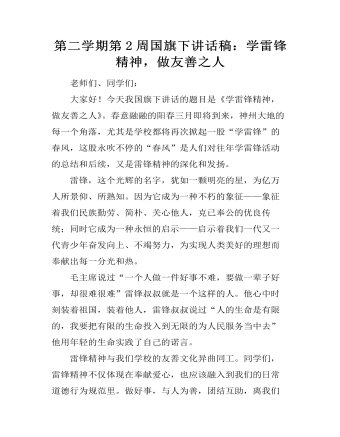
第二学期第2周国旗下讲话稿:学雷锋精神,做友善之人
老师们、同学们:大家好!今天我国旗下讲话的题目是《学雷锋精神,做友善之人》。春意融融的阳春三月即将到来,神州大地的每一个角落,尤其是学校都将再次掀起一股“学雷锋”的春风,这股永吹不停的“春风”是人们对往年学雷锋活动的总结和后续,又是雷锋精神的深化和发扬。雷锋,这个光辉的名字,犹如一颗明亮的星,为亿万人所景仰、所熟知。因为它成为一种不朽的象征——象征着我们民族勤劳、简朴、关心他人,克已奉公的优良传统;同时它成为一种永恒的启示——启示着我们一代又一代青少年奋发向上、不竭努力,为实现人类美好的理想而奉献出每一分光和热。毛主席说过“一个人做一件好事不难,要做一辈子好事,却很难很难”雷锋叔叔就是一个这样的人。他心中时刻装着祖国,装着他人,雷锋叔叔说过“人的生命是有限的,我要把有限的生命投入到无限的为人民服务当中去”他用年轻的生命实践了自己的诺言。

人教版新课标PEP小学英语六年级下册Recycle2 A Farewell Party教案
3. 新课呈现(Presentation) Let’s make (1)教师说:Miss White is making a book about her students. So she can remember them well.Who are the students? 请学生独立或分小组朗读四段短文,解释学生不理解的句子,然后说:There are four pictures below. Would you like to help Miss/White glue the pictures? 教师知道学生完成图文搭配的练习。 (2)教师发给每名学生一张铅画纸,说:Now please draw a picture of your best classmate. Then describe him or her.学生画一副最要好的同学的肖像,并在傍边配上对该同学的英语介绍。 学生上讲台介绍自己最要好的同学,请其他学生猜是谁,看谁说的生动又贴切,教师给予评价时注意强调第三人称单数形式的使用。 Story time 教师向学生展示Story time部分的教学挂图,指着最后一副图中的Zoom 和 Zip说 Look at the picture. Zoom and Zip are sad. They are saying goodbye to each other. Now let’s see What happened. 学生同桌之间合作阅读或是,然后教师提出问题Where is Zip going? Is this good news for zoom ? What grade is Zip going to be in? 教师放录音,学生录音跟读故事,然后再分角色朗读.
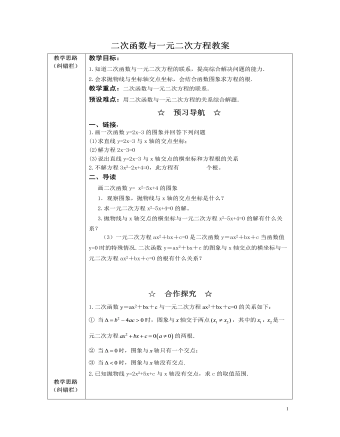
北师大初中九年级数学下册二次函数与一元二次方程2教案
教学目标:1.知道二次函数与一元二次方程的联系,提高综合解决问题的能力.2.会求抛物线与坐标轴交点坐标,会结合函数图象求方程的根.教学重点:二次函数与一元二次方程的联系.预设难点:用二次函数与一元二次方程的关系综合解题.☆ 预习导航 ☆一、链接:1.画一次函数y=2x-3的图象并回答下列问题(1)求直线y=2x-3与x轴的交点坐标; (2)解方程2x-3=0(3)说出直线y=2x-3与x轴交点的横坐标和方程根的关系2.不解方程3x2-2x+4=0,此方程有 个根。二、导读画二次函数y= x2-5x+4的图象1.观察图象,抛物线与x轴的交点坐标是什么?2.求一元二次方程x2-5x+4=0的解。3.抛物线与x轴交点的横坐标与一元二次方程x2-5x+4=0的解有什么关系?(3)一元二次方程ax2+bx+c=0是二次函数y=ax2+bx+c当函数值y=0时的特殊情况.二次函数y=ax2+bx+c的图象与x轴交点的横坐标与一元二次方程ax2+bx+c=0的根有什么关系?
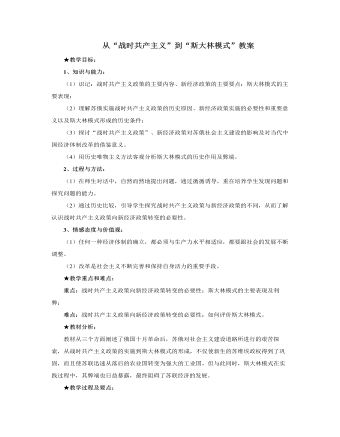
人教版高中历史必修2从“战时共产主义”到“斯大林模式”教案
5、弊端:(1)经济发展不均衡,片面发展重工业,使轻工业和农业长期处于落后状态;(2)对农民的剥夺太重,挫伤了农民的生产积极性;(3)长期执行指令性计划严重削弱了企业的生产自主权,不利于发挥企业的生产积极性,制约了苏联经济的可持续发展。(4)计划经济体制确立后,没有随着社会的变化进行调整,二战后逐渐僵化,丧失了自我完善的功能,成为苏联解体的重要因素。【合作探究】斯大林模式的评价及经验教训:积极:①使苏联迅速实现了 工业化②苏联经济实力的迅速增长,为反法西斯战争的胜利奠定了 物质基础 。消极:①政治:高度集权,破坏了 民主与法制 ; ②经济:优先发展重工业使 农业和轻工业长期处于落后状态,农民生产积极性不高;计划指令,压制了地方和企业的积极性,阻碍苏联经济的发展高度集中的计划经济体制,成为东欧剧变和苏联解体的重要原因。
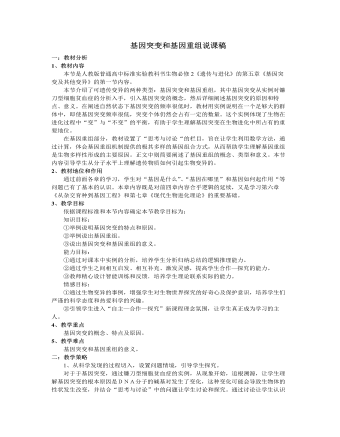
人教版高中生物必修2基因突变和基因重组说课稿
1、教材内容本节是人教版普通高中标准实验教科书生物必修2《遗传与进化》的第五章《基因突变及其他变异》的第一节内容。本节介绍了可遗传变异的两种类型:基因突变和基因重组,其中基因突变从实例对镰刀型细胞贫血症的分析入手,引入基因突变的概念,然后详细阐述基因突变的原因和特点、意义。在阐述自然状态下基因突变的频率很低时,教材用实例说明在一个足够大的群体中,即使基因突变频率很低,突变个体仍然会占有一定的数量。这个实例体现了生物在进化过程中“变”与“不变”的平衡,有助于学生理解基因突变在生物进化中所占有的重要地位。在基因重组部分,教材设置了“思考与讨论“的栏目,旨在让学生利用数学方法,通过计算,体会基因重组机制提供的极其多样的基因组合方式,从而帮助学生理解基因重组是生物多样性形成的主要原因。正文中则简要阐述了基因重组的概念、类型和意义。本节内容引导学生从分子水平上理解遗传物质如何引起生物变异的。
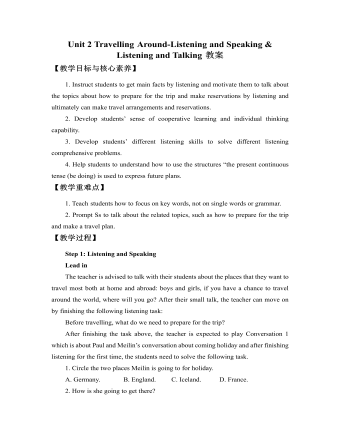
新人教版高中英语必修1Unit 2 Travelling Around-Listening and Speaking & Listening and Talking教案
【教学目标与核心素养】1. Instruct students to get main facts by listening and motivate them to talk about the topics about how to prepare for the trip and make reservations by listening and ultimately can make travel arrangements and reservations. 2. Develop students’ sense of cooperative learning and individual thinking capability. 3. Develop students’ different listening skills to solve different listening comprehensive problems.4. Help students to understand how to use the structures “the present continuous tense (be doing) is used to express future plans.【教学重难点】1. Teach students how to focus on key words, not on single words or grammar.2. Prompt Ss to talk about the related topics, such as how to prepare for the trip and make a travel plan.【教学过程】Step 1: Listening and SpeakingLead inThe teacher is advised to talk with their students about the places that they want to travel most both at home and abroad: boys and girls, if you have a chance to travel around the world, where will you go? After their small talk, the teacher can move on by finishing the following listening task:Before travelling, what do we need to prepare for the trip?

新人教版高中英语必修3Unit 2 Morals and Virtues-Discovering Useful Structure教学设计
1. 表示时间。Hearing these stories, I’m skeptical about the place. = When I heard these stories. . . 2. 表示原因。Not knowing his address, I can’t send this book to him. = Because/Since/As I don’t know his address. . . 3. 表示结果。His father died, leaving him a lot of money. =. . . and left him a lot of money4. 表示条件。Going straight down the road, you will find the department store. = If you go straight down the road. . . 5. 表示让步。Being tired, they went on working. =Although they were tired. . . 6. 表示行为方式、伴随情况或补充说明。He lay on the grass, staring at the sky for a long time. =. . . and stared at the sky for a long time注意:非谓语动词作状语时, 如所提供的动词不能和句子中的主语保持一致, 动词-ing形式必须有自己的逻辑主语, 通常由名词或代词来担任, 这就是独立主格结构。The last bus having gone, we had to walk home. (having gone的逻辑主语是the last bus, 而不是we)Weather permitting, the football match will be played on Friday. (permitting的逻辑主语是time, 而不是the football match)Step 7 Practice1. ________(study) hard, you are sure to get first prize. 2. People use plastic in their daily life, _______(leave) large amounts of waste. 3. ________(work) hard at your lessons, you are to succeed. 4. The old man, ____________(work) abroad for twenty years, is on the way back to his motherland. 5. ______________(finish) his homework, he was playing on the playground. Answers: 1. Studying 2. leaving 3. Working 4.having worked 5. Having finishedStep 8 HomeworkFinish the homework on Page 22.

新人教版高中英语必修3Unit 2 Morals and Virtues-Listening &Speaking&Talking教学设计
Example:One day, a poor boy who was trying to pay his way through school by sending newspapers door to door found that he only had one dime(一角)left. He was so hungry that he decided to beg for a meal at the next house.However, he lost his nerve when a lovely young woman opened the door. Instead of a meal he asked for a drink of water. She thought he looked hungry so she brought him a large glass of milk. He drank it slowly, and then asked, “How much do I owe you?” “You don’t owe me anything,” she replied, “Mother has taught me never to accept pay for a kindness.” “Then I thank you from the bottom of my heart.” With these words, Howard Kelly left that house.Years later the woman became badly ill and was finally sent to the hospital in a big city. Dr. Howard Kelly, now famous, was called in. When he heard the name of the town she came from, a strange light filled his eyes. Dressed in his doctor’s clothes, Dr. Kelly went into her room and recognized her at once. From that day on, he gave special attention to her, and decided to do his best to save her life.At last the woman was saved. Dr. Kelly asked the business office to pass the final bill to him. He looked at it and then wrote something on the side. The bill was sent to the woman’s room. She was afraid to open it because she was sure that it would take the rest of her life to pay for it off. Finally she looked, and the note on the side of the bill caught her attention. She read these words: “Paid in full with a glass of milk, Dr. Howard Kelly.” Tear of joy flooded her eyes.

新人教版高中英语必修3Unit 2 Morals and Virtues-Reading and Thinking教学设计
The topic of this part is “Learn to make choices in life”.The Listening & Speaking & Talking part aims at the moral dilemmas, and this part is about making choices in life. The heroin is Lin Qiaozhi, a famous medical scientist, made a great contribution to our country’s medical care. Most importantly, her life experience can inspire our students whether in studying or the development of career. she had moral dilemmas and life choices, which are similar to the students who will step into society. Besides, Lin has quite good virtues like kindness, self-improvement, insistence, job-loving , generosity and responsibility, which is worth being learned.Concretely, this article is a biography about Lin Qiaozhi. The article tells her whole life according the timeline, among which the life choices is emphasized. For example, whether married or chased her dream, returned home or stayed abroad, family or public, her choices all reflected her faith, spirit, responsibility and devotion.1. Fast reading to get the detailed information about Lin Qiaozhi; careful reading to do the deductive information.2. Learn the reading skills--deductive judgement according the context.3. Study the structure features and language features. 4. Communicate about Lin’s life choices and reflect their own life choices.1. Learn the reading skills--deductive judgement according the context.2. Study the structure features and language features.3. Communicate about Lin’s life choices and reflect their own life choices.Step 1 Lead in---Small talkWhat are some important life choices?Importance choices: university study, jobs and marriage partners. Because they can determine our future.

新人教版高中英语必修3Unit 2 Morals and Virtues-Reading for Writing教学设计
1. 这个寓言是一个关于一位国王古寓言。 The fable is an old fable about a king.2.作者用这个故事让读者对于社区的问题负有个人责任的必要印象深刻。The author used the story to impress upon readers with the need to take personal responsibility for problems in the community.3. 这个故事十分成功的实现了它的目的。The story was quite successful in achieving its purpose.Step 7 WritingPlease write a review of the story according the outline above.The fable is an old fable about a king who thought his people are lazy, so he put a large stone in the middle of the road and hides and waited to see if anyone will try to move it.The author used this story to impress upon readers with the need to take personal responsibility for problems in the community. The story was quite successful in achieving its purpose, and I liked it because it had a clear moral.However, while the moral of the story is clear, the actions of the king seemed pointless to me, because none of the characters in the story learnt anything. For this reason, I think there are better stories that can be used to impress upon people with the need for personal responsibility.Step 8 Pair workExchange drafts with a partner. Use this checklist to help your partner revise his/her draft.1. Does the writer give a short description of the story ?2. Does the description include the most important details of the story ?3. Does the writer give his or her opinion about the character or their actions ?4. Is the review well-organised ? 5. Does the writer use the -ing form as the adverbial correctly in the writing ?6. Are there any grammar, spelling, or punctuation errors ?Step 9 HomeworkPut up your revised draft in the classroom or read it to your class.

新人教版高中英语选修2Unit 1 Science and Scientists-Discovering useful structures教学设计
The grammatical structure of this unit is predicative clause. Like object clause and subject clause, predicative clause is one of Nominal Clauses. The leading words of predicative clauses are that, what, how, what, where, as if, because, etc.The design of teaching activities aims to guide students to perceive the structural features of predicative clauses and think about their ideographic functions. Beyond that, students should be guided to use this grammar in the context apporpriately and flexibly.1. Enable the Ss to master the usage of the predicative clauses in this unit.2. Enable the Ss to use the predicative patterns flexibly.3. Train the Ss to apply some skills by doing the relevant exercises.1.Guide students to perceive the structural features of predicative clauses and think about their ideographic functions.2.Strengthen students' ability of using predicative clauses in context, but also cultivate their ability of text analysis and logical reasoning competence.Step1: Underline all the examples in the reading passage, where noun clauses are used as the predicative. Then state their meaning and functions.1) One theory was that bad air caused the disease.2) Another theory was that cholera was caused by an infection from germs in food or water.3) The truth was that the water from the Broad Street had been infected by waste.Sum up the rules of grammar:1. 以上黑体部分在句中作表语。2. 句1、2、3中的that在从句中不作成分,只起连接作用。 Step2: Review the basic components of predicative clauses1.Definition

